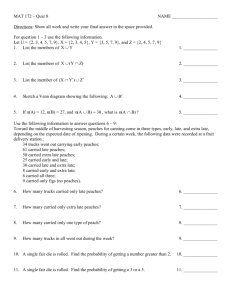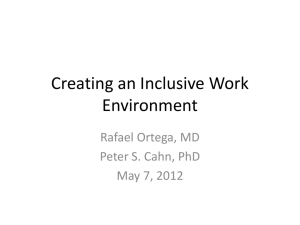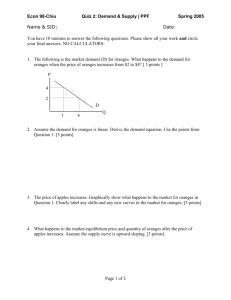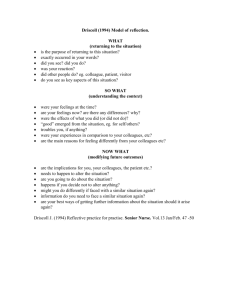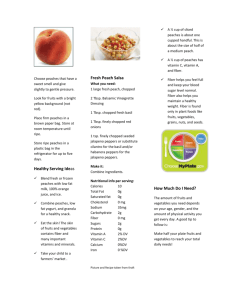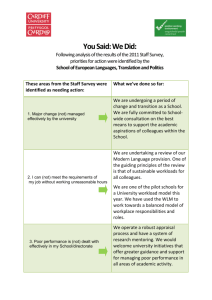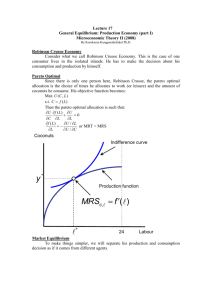Communication - English Language Courses in South West England
advertisement
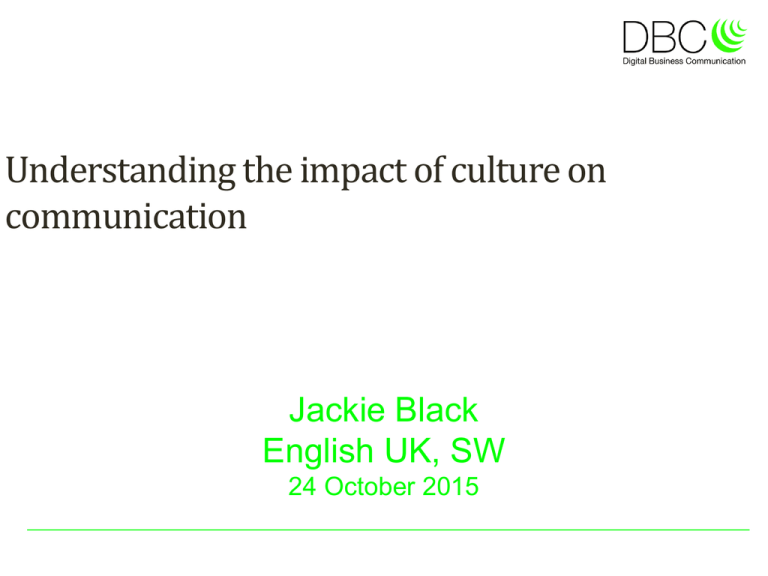
Understanding the impact of culture on communication Jackie Black English UK, SW 24 October 2015 What’s your communication style? Personal Communication Styles Distanced Personal Systematic Organic Formal Proactive Informal Reactive Complex Simple Direct Indirect Emotional Neutral Expansive Concise Closed Open Problem-oriented Solution-focused Encouraging Assertive Statement-maker Question-maker Content-oriented Relation-oriented Silent listener Active listener Norwegian-French styles more consensual more collectivist lower energy quieter slower paced linear more patient taking turns concern to save face respect shown through listening practice first experience admired more egalitarian comm. managed by the chair more belief-based (heart)? ←→ ←→ ←→ ←→ ←→ ←→ ←→ ←→ ←→ ←→ ←→ ←→ ←→ ←→ ←→ more competitive / confrontational more individualist higher energy noisier faster paced circular less patient talking over each other some may lose face respect shown through engaging theory first intellectual argument admired more hierarchical comm. managed by the boss more analytical (head)? International dialogue patterns 1. 2. 3. Riding the Waves of Culture: Understanding Cultural Diversity in Business, FonsTrompenaars & Charles Hampden Turner One view of culture Culture and Diversity Which one are you? Personal perceptions Negative: Positive: Coconuts see peaches as … Peaches see coconuts as … - superficial - not to be taken seriously - childish - too playful - in - unapproachable - hard - rigid in approach - impolite - lacking humour - gruff - Unfriendly / unsociable Coconuts see peaches as … Peaches see coconuts as … - open - enthusiastic - friendly - humorous - flexible - reliable - proper - clear - honest - ustworthy Handling diversity Negative: Positive: Coconuts see peaches as … Peaches see coconuts as … - superficial - not to be taken seriously - childish - too playful - insincere - unapproachable - hard - rigid in approach - impolite - lacking humour - gruff - Unfriendly / unsociable Coconuts see peaches as … Peaches see coconuts as … - open - enthusiastic - friendly - humorous - flexible - reliable - proper - clear - honest - trustworthy What are the practical implications of this model? How do we work? Do you think you live and work in a high or low context culture? High Indirect communication Implicit messages Context important for understanding Avoid saying “no” Maintain harmony Long-term relationships Strong personal networks Low Direct communication Words contain the real meaning Say “no” Surface conflict Short-term relationships Task-based networks Culture, directness and trust High context Indirect People important Low context Direct Task important Take the “Person or task?” quiz Task-focused or Concentration of technical aspects of work. Little small talk, distance from personal questions. Person-focused? Concentration on relationships with people at work. A lot of small talk, interest in personal questions. Interest created by information, logic, technical data Interest created by relationships, trust, prestige. Customers stay with the product even if the sales representative changes. Customers stay with the sales representative even if he or she changes firm. Results have priority over harmony and “face”. Results come from harmony and “face”. People with expert knowledge are valued. People with many relationships are valued. Distance from people who are not useful. Distance from people who are not loyal. Conflicts resolved by logical use of arguments, contracts, laws and compromise. Conflicts resolved by evidence of loyalty, prestige, mediators, authority figures and new formulations. People concentrate on the task. People mix work and private life. Friends and colleagues are kept separate. Colleagues are also friends. Task-focused or person-focused? Place yourself along the line. 0 1 2 3 4 5 6 7 8 If you have more in column “T”, you are task-focused. If you have more in column “P”, you are peoplefocused 9 10 What’s going on? A group of German academics were meeting for a Friday afternoon seminar. A paper was presented, after which there was a heated discussion. An American guest professor was disturbed by the atmosphere, and had the impression that the professors didn’t like each other at all. She was surprised that after the discussion had ended they all left the room in a good mood, wishing each other a good weekend. The German professors were focused on the task at hand (i.e. the discussion of the academic paper), while the US colleague was concentrating on the relationship between the people present and misinterpreted the tone of heated discussion as meaning that the people didn’t like each other. Managing Communication channels Virtual team experiences Relationships / Interpersonal factors Communication We never meet. I can’t get hold of him. We don’t have any chance to build a relationship. I don’t know what is going on. I can’t read the body language. I don’t really know how to work with him. I can’t understand him. We’re not really a team. I don’t know what she’s thinking. It’s difficult to build trust. I can’t get a word in. I contribute more than the others. I can’t get a decision. Task versus technology Synchronous Asynchronous VoIP Web Meetings Video Conferencing Audio Conferencing Personal Webcams Phoning Telepresence Threaded discussions Messaging SMS Wikis E-mail Rich Communication http://blog.timebarrow.com/2009/09/mediarichness-theory/ Case study: the right message? Background: Tim (British) and Janine (Australian) are both leaders of small teams which are part of a much bigger multinational team spanning 5 continents.They have never met , but have worked together on several projects in the past. They have always communicated with each by email because of time differences. Situation: the current project is due to end shortly but there are some tasks outstanding and deadlines are fast approaching. Tim is anxious to know what is going on so meets with Phil one of his less experienced team members based in Kuala Lumpur. He returns to London worried and drafts a mail to Janine. Matching technology to task •Relationships •Results •Communication Complex collaboration Simple collaboration Real-time collaboration Delayed-time collaboration VoIP Web Meetings Video Conferencing Instant Messaging Audio Conferencing Threaded discussions Email Smartphones Best practices • Maximise any opportunity for face to face contact, especially at the beginning of a project to allow for relationship building • Don’t rely too much on email. Use email for information exchange not sensitive communication. • Avoid giving any kind of feedback via email where possible. • Book phone calls well in advance because task and time-oriented people may not cope well with unexpected calls. • In virtual projects, use the phone to build relationships but also consider using on-line presentations to bring the team together. • Use conference calls for top-down messages as it allows the team to respond personally. • Communicate frequently to ensure everyone knows what’s going on. • Remember the acronym KISS in all forms of communication. Native English speakers Do • Speak slowly and build in more pauses • Use simple words and sentences (active vs passive / if / complex frames) • Articulate clearly and project strongly • Take care with contractions, weak forms and ends of words • Avoid unnecessary filling phrases • Reformulate, summarise, and check understanding often • Facilitate others • Listen to other people and listen to yourself • Ask someone for clarification if you don’t really understand their point Don’t • Try to be funny • Be ambiguous • Make local (i.e. British / American etc.) cultural references • Use idiom, colloquial expression or complicated grammatical forms • Dominate the talking time with overlong interventions What the British say ... Thanks for listening! Any questions? SUPPLEMENTARY MATERIAL Building relationships • What is do we mean? • Why is it important? • How good are you at it? • What skills do you need to exercise it? • What advice would you give someone who needed to improve their relationship building skills? DIVERSITY Leadership and organisational characteristics Germany UK Spain Switzerland (D) North America Technical expertise Status driven ‘Serious’ Generalists Pragmatic attitude False modesty’ Personal, charismatic and creative (not ‘position’ based) Sophisticated manner ‘Job-hopping’ generalists Inspirational Open door policy Informality Territorial Collectivist Teamwork Planning Professional communication Relationships On the surface ... flatter hierarchies than others Personal alliances (Benevolent autocracy) Networking behind the scenes ‘Upward and downward flow Measured roles Opportunity to outperform Specialists with clear roles led by responsible experts Individualist orientation but belief in collaboration and participative decision-making Building personal relationships to support doing the task Structured with time for relationships Individualists with A-team ethic Detailed Analytical Rule-bound Consensusoriented Increasing systematic approach Risk tolerant Value flexibility and creativity Detailed and methodical Action oriented Short termism Structured Formal Data focused Implicit feedback Pragmatic and harmony seeking Humour Linguistic cleverness Unstructured, creative and showy Task-based and structured ‘Can do’ Positive feedback Self-marketing ‘Authentic coconuts’ Polite and indirect Personal warmth although some initial reservation ‘More easy going than Germany.’ ‘Friendly peaches.’ Positive and enthusiastic Direct and Indirect Expressive show Belief in Tough 1. Time Zones and Languages •81% indicated time zones presented the greatest general hurdle to virtual teams •64% who found language (accents and dialects) to be a barrier 2. Communication style •94% said the inability to read non-verbal cues is very challenging •90% stated the absence of face-to-face contact interfered with the ability to build a relationship (which is perceived as a challenge facing virtual teams) •81% said being virtual made it more difficult to establish trust and rapport 3. Cultural differences • 80% said that virtual teams slowed down decision making •77% were hampered by different leadership styles •76% felt the method of decision-making was a challenge April 2010, RW3 CultureWizard:randomly selected employees of multinational corporations. 600 completed surveys Ask questions to move the group forward in its discussions. Just feel free to give any ideas ... Let’s just collect a few ideas to begin ... Just say what’s in your mind about ... No decision has been made so feel free to ... Make people feel comfortable to speak. What would be a good way to proceed here? Should we focus more on ... Could we move onto to look at ... I think time is pressing and we should discuss ... Paraphrase what others have said to confirm your (or others’) understanding. So if I understood you correctly, you mean that ... So for you the most important thing is ... To summarise what you just said, ... Just to make sure I understand, you’re saying that ... Bridge between the thoughts and ideas of others so as to move the whole group forward. Encourage alternative viewpoints from others. John, you said this. Alex, you said that. Peter, any comments? Luis, what do you think about Bob’s idea? Can we take the best of these ideas and think about ... If we keep these ideas in mind, let’s move onto look at ... Could you play devil’s advocate for a moment? Sue, is there another way of looking at this? Luana, how would a customer think about this? If we put ourselves into their shoes, what would ... Using instant messaging Processing the input (overview, documented complaints, anecdotal comments) Establishing connections for messaging / emailing Storming to norming - how to move towards a consensualised document (agenda) Carrying out process Agreeing on final output •Writing strips out the EMOTION so it removes the expressive element of communication (voice, verbal discussion, interaction, rhetoric). •BUT... It enhances the procedural aspects of the task because it imposes certain linguistic rules and boundaries in terms of comprehensiveness and appropriateness. It is multi-directional among 4 or 5 people and, if done with commitment and a positive and collaborative attitude, it can be a powerful and effective mode of communication. •For those with less fluency in the language, greater opportunity for articulation and intervention Critical incidents 1.Team members from Sweden are losing patience with their French colleague. During teleconference meetings he never sticks to the point and keeps dominating and side-tracking the discussion with over-complex arguments. A great deal of time is wasted and often outcomes are not reached. The Swedes decide to set communication guidelines regarding meeting process to be implemented next month. 2. A team member from Italy finds her colleague from Finland very cold because he says very little and answers simply ‘Yes’ and nothing more to the personal questions she asks him in an attempt to make small talk at the beginning of their weekly conference call . 3. A U.S. manager working on an international project decides to praise a Japanese team member who has done a good job in front of his international colleagues during the next video conference call. Afterwards, he reflects that the Japanese colleague seemed uncomfortable with this approach. Critical incidents 2 4. Simone is horrified following a contract negotiation in Beijing. She had arrived home following a meeting when there was explicit verbal agreement about changes to the scope of her project, and sent an email to her Chinese colleagues confirming the agreement. In her inbox is an email refusing to accept that an agreement was reached. It even states that some discussions summarised by Simone never took place. 5.Sylvie, a project leader from Germany, is irritated by her British colleagues. They often deliver engaging presentations to the Steering Committee of the project which are accepted. But when the German team has to implement the ideas they find that they are not well thought out and lack detail. Sylvie begins to see her British colleagues as unprofessional and playing games to win influence in the project. She tells her team to be careful of close collaboration with their British colleagues 6.Jack is a controller in New York. He has asked a local country manager in India to supply key data several times. Despite promises made on the phone the week before, nothing has happened. Jack decides to escalate the matter to his board member in order to speed up the process Useful References 1. The International Profiler by World Work (psychometric tool for assessing people’s challenges when working internationally) 2. Riding the waves of culture: understanding cultural diversity by Fons Trompenaars and Charles Hampden-Turner 3. The peach and the coconut analogy; Fons Trompenaars and Susanne Zaninelli 4. Cultural dimensions by Geert Hofstede
